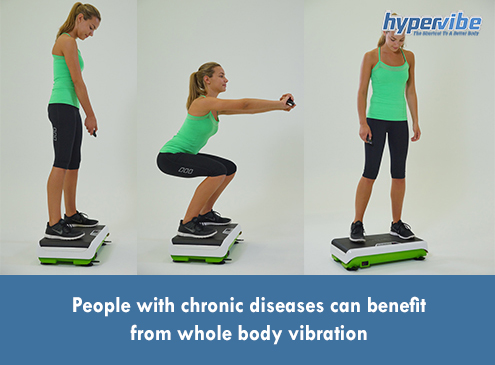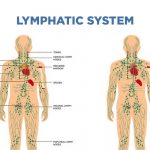People with chronic diseases can benefit from whole body vibration

When we refer to a condition as “chronic”, we define an ailment that is long-lasting and has no known cure.
In this category of chronic ailments we can include cancer, diabetes, heart disease and stroke, arthritis, asthma, epilepsy, seizures and obesity, ALS (also known as Lou Gehrig’s disease), Alzheimer’s disease, COPD (chronic obstructive pulmonary disease) and osteoporosis.
According to the CDC, about half of Americans suffer from at least one chronic condition, these ailments being responsible for 7/10 deaths in the U.S. and the leading cause of disability and death in the United States. In those aged 65 years and older, the prevalence of chronic diseases is even higher, statistics showing that 88% of Americans over the age of 65 have at least one chronic disease.
Data from the World Health Organization shows that globally, chronic diseases cause twice as many deaths as infectious diseases, including HIV, tuberculosis or malaria, combined with nutritional deficiencies and perinatal conditions. Also, statistics show that 80% of all the deaths caused by chronic diseases occur in low and middle income countries, women being more affected.
What causes chronic conditions?
A damaging lifestyle with behaviors such as tobacco and alcohol use, poor eating habits or the lack of physical activity contribute to the occurrence of chronic conditions. However, the causes may vary from one ailment to another.
Arthritis for example can be caused by injuries (osteoarthritis), but also by metabolic abnormalities, genes, infections – both bacterial and viral, or by autoimmune conditions in which the body mistakenly attacks its healthy cells. Arthritis and related ailments affect around 43 million Americans, and can interfere with one’s ability to perform daily tasks, as it affects the joints, causing stiffness, swelling, pain and reduced flexibility.
Diabetes, an increasingly common chronic ailment, occurs when there’s an insufficient production of insulin, or when the body is unable to process insulin properly. People with diseases of the pancreas or with certain infections, those with high blood pressure, obese and overweight individuals, those with elevated levels of bad cholesterol and triglycerides, as well as people with sedentary lifestyles are more likely to develop diabetes. This ailment affects more than 20% of people aged 65 years and older, type 2 diabetes being more common than type 1.
Obesity may not seem like a threatening condition, but it’s considered a chronic ailment, and the percentage of adults affected by obesity has doubled in the past 30 years. Obese people are at higher risk for high blood pressure and heart disease, diabetes, arthritis and some forms of cancer.
Stroke is more likely to occur in people with high blood pressure, in those with high levels of bad cholesterol, in diabetes sufferers and people who smoke, the most common cause of stroke being the formation of blood clots that block arteries in the brain. When a blood vessel becomes blocked, that part of the brain is no longer supplied with blood and oxygen, thus the tissue begins to die and the body parts controlled by those cells stop working as well.
Chronic respiratory diseases such as COPD appear more frequently in people who live in areas with increased air pollution, in those who are exposed to chemical substances and pollutants at work, in tobacco users, people with a history of childhood pneumonia and in those who work in unventilated kitchens.
Chronic conditions that can be improved through whole body vibration
Not all chronic conditions can be improved with whole body vibration exercises; each of these ailments requires a specific approach, as the symptoms are different, but there are some chronic ailments that can benefit from vibration therapy, and we’ll list them here.
Rheumatoid arthritis patients can improve their functional ability, meaning the ability to perform basic activities like shopping, dressing, bathing or housework, through regular whole body vibration exercises. In a study done on 31 females with rheumatoid arthritis, 15 minutes of vibration therapy, twice per week, repeated for three months, led to significant improvements in functional ability.
At the same time, vibration therapy helped in reducing fatigue and in maintaining the bone mass density, while the control group saw a decrease in the hip bone mineral density. It was concluded that intermittent vibration exercises can be a potential solution for patients with rheumatoid arthritis who suffer from bone loss and fatigue.
In osteoarthritis patients, vibration training done three times per week, for 12 weeks, can reduce inflammation, improving gait quality and balance and reducing pain. Korean researchers have also found vibrating platform exercises to reduce pain and to increase the strength of muscles in the lower body in people affected by chronic knee osteoarthritis.
Scientists from Florida showed that WBV therapy can improve physical performance of OA sufferers, being a safe and viable solution for this group of people. Danish scientists have also found whole body vibration to help in improving muscle strength and proprioception in OA patients.
In diabetes patients, whole body vibration can be a solution for enhancing skin blood flow and improving the symptoms of diabetic neuropathy. Low-frequency, low-amplitude vibration was found to increase circulation in people affected by this condition, being a safe treatment for diabetes sufferers who can’t practice regular forms of physical activity.
Vibration machine exercises can also be helpful in patients with COPD, Dutch researchers showing that 15 minutes of WBV daily, done after 15 minutes of aerobic exercises, can improve the maximum exercise capacity and the walking distance test results, contributing to a better pulmonary capacity and quality of life.
Patients affected by Parkinson’s disease (PD) can also benefit from whole body vibration therapy, studies showing that this form of physical activity can lead to improvements in postural control and motor symptoms in PD sufferers. One study found vibration therapy (25 Hz, two 15-minute sessions per day, 5 days per week) to be equally effective in improving balance and motor function to conventional balance training, so if you suffer from PD and don’t have enough time for regular exercise or find it too tiring, you can try vibration exercises as an alternative.
Another chronic condition that can benefit from vibration therapy is multiple sclerosis (MS), which leads to symptoms like spasticity, motor weakness and poor balance. Studies have shown that exercising on a vibration machine can improve lower extremity performance and balance in MS patients, being safe both alone and in combination with conventional exercise therapy.
In stroke recovery, vibration exercises can help in improving postural control and muscle performance. Also, it’s been found that in patients with spinal cord injuries, exercising on a vibrating platform can improve the gait speed more efficiently than body-weight supported treadmill training.
Hope you’ll find this article useful. If you have questions, comment below or join our Facebook community and share your thoughts with us there!







